




Your support is critical to our success.
Bradleya 9: 88 (1991); et: Cact. d'Argentine ed. 2: 57, isonym. 1997 1998
Family: CACTACEAE

P 238 Portero, Salta, Agentina. Big rich red flowers with stiff dark spines. A real eye catcher! The plants from the locality of Portero Salta, Agentina have a squat black/green body with black spines on white aeroles. Then, when older, the plant produces wild black curly spines, and 4-5 cm, slightly hooked centrals.
Origin and Habitat: Echinopsis haematanthaSN|12412]]SN|12412]] has a relatively wide range in Northern Argentina (Salta and Catamarca)
Type locality: Amblayo, province of Salta.
Altitude: 1800 to 3600 metres above sea level.
Habitat and Ecology: The species grows in shrublands on rocky soils, at high altitudes. It is locally abundant, but the populations are very fragmented.
Synonyms:
- Echinopsis haematantha (Speg.) D.R.Hunt
- Echinocactus haematanthus Speg.
- Lobivia haematantha (Speg.) Britton & Rose
Echinopsis haematantha (Speg.) D.R.Hunt
Bradleya 9: 88 (1991); et: Cact. d'Argentine ed. 2: 57, isonym. 1997 1998
Synonymy: 44
- Echinopsis haematantha (Speg.) D.R.Hunt
- Echinocactus haematanthus Speg.
- Lobivia haematantha (Speg.) Britton & Rose
- Echinopsis amblayensis (Rausch) Friedrich
- Echinopsis densispina var. amblayensis (Rausch) J.G.Lamb.
- Lobivia amblayensis Rausch
- Lobivia haematantha var. amblayensis (Rausch) G.D.Rowley
- Lobivia haematantha subvar. amblayensis (Rausch) Rausch
- Echinopsis amblayensis var. albispina (Rausch) Friedrich
- Echinopsis haematantha subs. chorrillosensis (Rausch) J.G.Lamb.
- Lobivia chorrillosensis Rausch
- Lobivia haematantha subs. chorrillosensis (Rausch) Rausch
- Lobivia haematantha var. chorrillosensis (Rausch) Rausch
- Lobivia haematantha subvar. chorrillosensis (Rausch) Rausch
- Echinopsis haematantha subs. elongata (Backeb.) J.G.Lamb.
- Echinopsis elongata (Backeb.) H.Friedrich & Glaetzle
- Lobivia elongata Backeb.
- Lobivia haematantha var. elongata (Backeb.) Rausch
- Echinopsis haematantha subs. hualfinensis (Rausch) J.G.Lamb.
- Echinopsis hualfinensis (Rausch) Friedrich & Glaetzle
- Lobivia haematantha var. hualfinensis (Rausch) Rausch
- Lobivia hualfinensis Rausch
- Echinopsis haematantha subs. hualfinensis f. variegata hort.
- Echinopsis haematantha subs. jasimanensis (Rausch) J.G.Lamb.
- Echinopsis haematantha var. kuehnrichii (Frič) J.G.Lamb.
- Andenea kuehnrichii Frič & Kreuz.
- Echinopsis kuehnrichii (Frič) Friedrich & Glaetzle
- Hymenorebutia kuehnrichii (Frič) F.Ritter
- Lobivia cincero Frič in Möller
- Lobivia haematantha subs. kuehnrichii (Frič) Rausch ex G.D.Rowley
- Lobivia haematantha var. kuehnrichii (Frič) Rausch
- Lobivia kuehnrichii Frič in Möller
- Lobivia drijveriana Backeb.
- Hymenorebutia drijveriana (Backeb.) F.Ritter
- Lobivia haematantha var. drijveriana (Backeb.) G.D.Rowley
- Lobivia drijveriana var. astranthema Backeb.
- Lobivia drijveriana var. aurantiaca Backeb.
- Lobivia drijveriana var. nobilis Backeb.
- Lobivia haematantha var. fechseri (Rausch) Rausch
- Lobivia haematantha subvar. fechseri (Rausch) Rausch
- Lobivia hualfinensis var. fechseri Rausch
- Lobivia mirabunda Backeb.
RUSSIAN (Русский): Эxинопсис кровавоцветковый
Description: It is a very interesting but extremely variable species, with many forms and varieties. It is a geophyte cactus, usually solitary, or slowly branching to form small clumps.
Stem: Somewhat depressed, globose to short cylindrical. Silky, somewhat shining, grey-green, bluish, olive- green to pinkish or brownish-green, 5-8(-12) cm tall, 5-7 cm in diameter.
Ribs: 8 to 15, vertical or slightly spiralling, somewhat tuberculate, obtuse, narrow.
Areoles: Nearly circular, 5-6 mm in diameter, white, felted.
Spines: Heavy, curving, yellowish, pink/brown, orangish dark brown or black..
Central spines: Usually 1 to 4, unequal, stouter than the radials, curly, often hooked, 3-6 cm long.
Radial spines: 6 to 12, slender ± interlacing, needle-like, and more or less appressed, 05-1cm long, pale grey with a darker yellow tip.
Flower: Diurnal, broadly funnel-form, yellow to purple with usually a white or yellowish-cream throat circle, 3-4 cm wide, inner perianth segments spatulate to obovate, obtuse, stigma lobes 9-12, white. Scales on flower tube with long wool.
Fruits: Globose to ovoid, green to brownish-violet, semidry, dehiscent.
Roots: Large taproot, carrotlike.
Subspecies, varieties, forms and cultivars of plants belonging to the Echinopsis haematantha group
 Echinopsis amblayensis (Rausch) Friedrich: has rich orange-red flowers and green stigmas. Distribution: Amblayo, Salta, Argentina.
Echinopsis amblayensis (Rausch) Friedrich: has rich orange-red flowers and green stigmas. Distribution: Amblayo, Salta, Argentina. Echinopsis amblayensis var. albispina (Rausch) Friedrich: has short, glassy, mostly cream white in variable number. Distribution: Amblayo, Salta, Argentina.
Echinopsis amblayensis var. albispina (Rausch) Friedrich: has short, glassy, mostly cream white in variable number. Distribution: Amblayo, Salta, Argentina. Echinopsis haematantha (Speg.) D.R.Hunt: is an extremely variable species, with many forms and varieties. Flowers yellow to purple with usually a white or yellowish-cream throat circle. Distribution: Northern Argentina (Salta and Catamarca)
Echinopsis haematantha (Speg.) D.R.Hunt: is an extremely variable species, with many forms and varieties. Flowers yellow to purple with usually a white or yellowish-cream throat circle. Distribution: Northern Argentina (Salta and Catamarca) Echinopsis haematantha subs. chorrillosensis (Rausch) J.G.Lamb.: has a deep taproot, greyish-green stems, short pale radial spines, longer curved central spine and flower colour from red through to yellow. Distribution: Chorrillos, Salta, Argentina.
Echinopsis haematantha subs. chorrillosensis (Rausch) J.G.Lamb.: has a deep taproot, greyish-green stems, short pale radial spines, longer curved central spine and flower colour from red through to yellow. Distribution: Chorrillos, Salta, Argentina.- Echinopsis haematantha subs. elongata (Backeb.) J.G.Lamb.
 Echinopsis haematantha subs. hualfinensis (Rausch) J.G.Lamb.: has silky grey-green, olive-green to brownish-green stems, heavy, curving spines and orange to bright red flowers, with a white or yellowish throat circle. Distribution: Northern Argentina.
Echinopsis haematantha subs. hualfinensis (Rausch) J.G.Lamb.: has silky grey-green, olive-green to brownish-green stems, heavy, curving spines and orange to bright red flowers, with a white or yellowish throat circle. Distribution: Northern Argentina. Echinopsis haematantha subs. hualfinensis f. variegata hort.: has green and yellow variegated stems. Garden origin.
Echinopsis haematantha subs. hualfinensis f. variegata hort.: has green and yellow variegated stems. Garden origin.- Echinopsis haematantha subs. jasimanensis (Rausch) J.G.Lamb.
 Echinopsis haematantha var. kuehnrichii (Frič) J.G.Lamb.: has yellow, salmon, orange or carmine flowers up to 5 cm wide. The flowers throat is white or green. Distribution: Cachipampa to Potrero, Salta, Argentina.
Echinopsis haematantha var. kuehnrichii (Frič) J.G.Lamb.: has yellow, salmon, orange or carmine flowers up to 5 cm wide. The flowers throat is white or green. Distribution: Cachipampa to Potrero, Salta, Argentina. Lobivia drijveriana Backeb.: same as Echinopsis haematantha var. kuehnrichii? Distribution: Cachipampa to Cachi, Salta, Argentina.
Lobivia drijveriana Backeb.: same as Echinopsis haematantha var. kuehnrichii? Distribution: Cachipampa to Cachi, Salta, Argentina.- Lobivia haematantha var. fechseri (Rausch) Rausch
- Lobivia mirabunda Backeb.
Bibliography: Major references and further lectures
1) Nathaniel Lord Britton, Joseph Nelson Rose “Cactaceae: Descriptions and Illustrations of Plants of the Cactus Family” Courier Dover Publications, 1963
2) James Cullen, Sabina G. Knees, H. Suzanne Cubey “The European Garden Flora Flowering Plants: A Manual for the Identification of Plants Cultivated in Europe, Both Out-of-Doors and Under Glass” Cambridge University Press, 11/Aug./2011
3) David Hunt, Nigel Taylor “The New Cactus Lexicon” DH Books, 2006
4) Edward F. Anderson “The Cactus Family” Timber Press, 2001
5) Clive Innes, Charles Glass “Cacti” Portland House, 01/May/1991
6) Ortega-Baes, P., Lowry, M. & Méndez, E. 2013. Echinopsis haematacantha. In: IUCN 2013. "IUCN Red List of Threatened Species." Version 2013.2. <www.iucnredlist.org>. Downloaded on 04 January 2014.

Echinopsis haematantha Photo by: Valentino Vallicelli
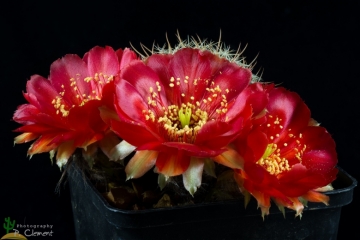
Echinopsis haematantha Photo by: Peiffer Clement
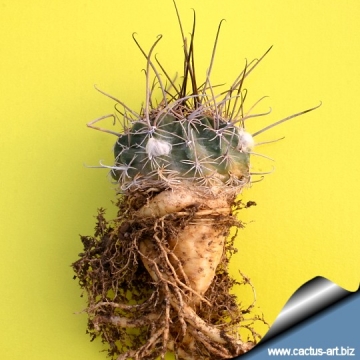
Echinopsis haematantha Photo by: Cactus Art
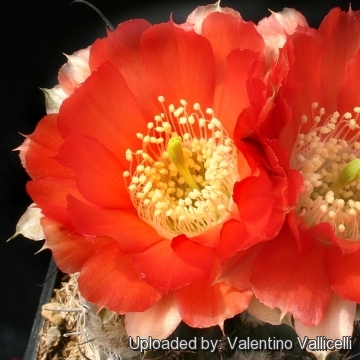
Echinopsis haematantha Photo by: Valentino Vallicelli

Echinopsis haematantha Photo by: Cactus Art
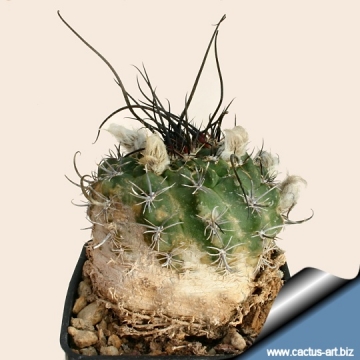
Echinopsis haematantha Photo by: Cactus Art

Echinopsis haematantha Photo by: Cactus Art
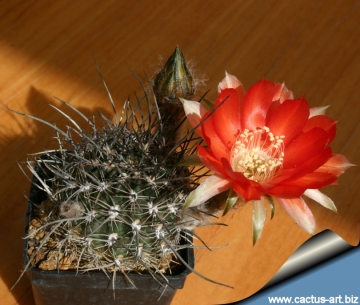
Echinopsis haematantha Photo by: Cactus Art
Cultivation and Propagation: It is a summer grower species that offers no cultivation difficulties.
Soil: Needs a large pot to accommodate a large root system. Use a very draining and porous substrate that allows therefore roots to breath, since it's natural habitat is in volcanic soil, it has adapted to more acidic conditions.
Water: They like only a short winter's rest and should be kept almost completely dry during the winter months, If the soil is allowed to be dry for too long root loss could follow but equally the same result would occur if the plants are both wet and cold. From March onwards the plant will begin to grow and watering should be increased gradually until late May when the plant should be in full growth. Water regularly during the summer so long as the plant pot is allowed to drain and not sit in a tray of water. During hot weather you may need to water the plants more frequently so long as the plant is actively growing. From late September watering should be reduced to force the plant to go in to a state of semi dormancy, by October you should be back in to the winter watering regime.
Exposure: It needs full sun avoiding only the harshest summer sun, if kept too dark it may become overly lush and greener and could be prone to rotting due to over watering.
Fertilization:Feeding may not be necessary at all if the compost is fresh then, feed in summer only if the plant hasn't been repotted recently. Do not feed the plants from September onwards as this can cause lush growth which can be fatal during the darker cold months.
Hardiness: It is quite frost resistant if kept dry (hardy to -5° C)
Maintenance: They should be re-potted frequently until they attain their desired size.
Pests & diseases: It is especially susceptible to spider mite mealybugs and scales infestation.
Propagation: Direct sow after last frost (it seldom produces offsets)
| Your Actions | |
|---|---|
| Back to Echinopsis index | |
| Back to Cactaceae index | |
 |
Back to Cacti Encyclopedia index |
Privacy stantement - Terms and conditions - How to cite - About us - Feedback - Donate



